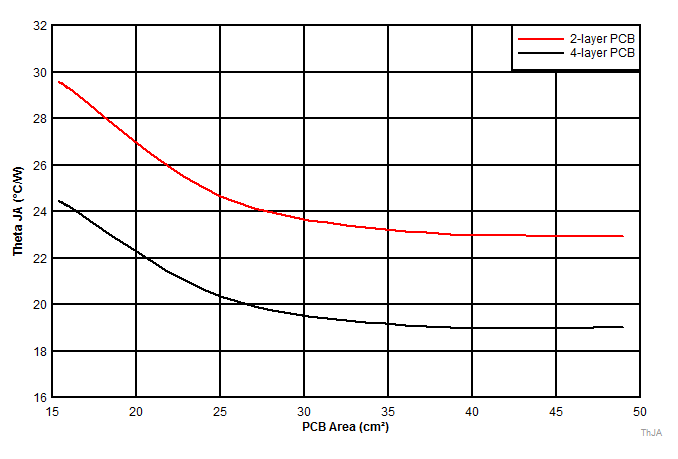ZHCSHM1C September 2017 – March 2018 LMZM33603
PRODUCTION DATA.
- 1 特性
- 2 应用
- 3 说明
- 4 修订历史记录
- 5 Pin Configuration and Functions
- 6 Specifications
-
7 Detailed Description
- 7.1 Overview
- 7.2 Functional Block Diagram
- 7.3
Feature Description
- 7.3.1 Adjusting the Output Voltage
- 7.3.2 Feed-Forward Capacitor, CFF
- 7.3.3 Output Current vs Output Voltage
- 7.3.4 Voltage Dropout
- 7.3.5 Switching Frequency (RT)
- 7.3.6 Synchronization (SYNC)
- 7.3.7 Input Capacitors
- 7.3.8 Output Capacitors
- 7.3.9 Output On/Off Enable (EN)
- 7.3.10 Programmable Undervoltage Lockout (UVLO)
- 7.3.11 Power Good (PGOOD)
- 7.3.12 Overcurrent Protection (OCP)
- 7.3.13 Thermal Shutdown
- 7.4 Device Functional Modes
- 8 Application and Implementation
- 9 Power Supply Recommendations
- 10Layout
- 11器件和文档支持
- 12机械、封装和可订购信息
10.3 Theta JA vs PCB Area
The amount of PCB copper effects the thermal performance of the device. Figure 42 shows the effects of copper area on the junction-to-ambient thermal resistance (RθJA) of the LMZM33603. The junction-to-ambient thermal resistance is plotted for a 2-layer PCB and a 4-layer PCB with PCB area from 16 cm2 to 49 cm2.
To determine the required copper area for an application:
- Determine the maximum power dissipation of the device in the application by referencing the power dissipation graphs in the Typical Characteristics section.
- Calculate the maximum θJA using Equation 5 and the maximum ambient temperature of the application.
- Reference Figure 42 to determine the minimum required PCB area for the application conditions.
Equation 5. 

 Figure 42. θJA vs PCB Area
Figure 42. θJA vs PCB Area